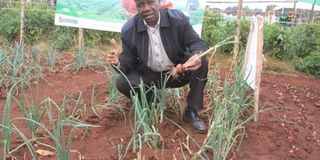A to Z of growing finest onions in the market

Isaac Nzuka with a new onion variety at Wambugu farm in Nyeri on July 25, 2014. FILE PHOTO | JOSEPH KANYI |
What you need to know:
- Onions are generally long-day plants, which means, they need more than 12 hours of daylight.
- Usually, onions are harvested when the tops turn down and start to dry.
Before you get tempted to engage in onion farming, do your homework well and learn from the masters who are already in the agribusiness. However, here is information to give you a head start.
The land should be more or less flat and have access to irrigation water. The soil should be light and well-draining. It must be free of aggressive weeds like couch grass and should also be in full sun.
Have the soil tested to make informed decisions on your soil fertility management decisions. Onions need a pH of 6 to 6.8. If the pH is below 6, apply calcitic lime at the rate recommended by your soil test results.
Prepare the land about a month before and incorporate about three tonnes of chicken manure. Loosen the soil deeply and prepare the land to a fine tilth.
Start with a small seedbed, which can either be raised if water is not a problem or sunk to capture more water. Prepare it 4ft wide with eight rows 10 to 15cm apart. Make 1cm deep furrows along the rows.
Per acre you will need about 1kg of seeds. Mix them with the same amount of sand. Fill the furrows evenly with the sand-seed mix.
KEEP WATERING
Cover with high quality fine compost and water thoroughly. Keep watering several times per day until the rows of onions have emerged. The seedlings remain in the seedbed for eight to 10 weeks and daily watering is important.
After four weeks, apply liquid fertiliser made from stinging nettle. As soon as seedlings have emerged, keep applying a layer of compost as a mulch to suppress weeds, and keep the soil moist and protected from heavy rains.
Onions are generally long-day plants, which means, they need days with more than 12 hours of daylight. Therefore, only varieties with lower day-length needs can be grown in Kenya.
Popular varieties are Jambar F1 (for size and high yield) or Red Passion F1, Bombay Red and Red Pinoy (they have a lower yield but are in high demand at the market and fetch a high price than Jambar F1).
Onions need around four months to mature. The last three weeks before harvest, the weather should be absolutely rain-free. So plan to start your nursery according to your dry season and count back four-and-a-half months. To harvest end of December, start your seedbeds mid-August.
Transplant when your seedlings have gained the size of a pencil and show four to five leaves. Prior to transplanting, water the seedbeds heavily until they are saturated to avoid damage to the seedlings.
To help your seedlings recover quickly after transplanting, prepare a liquid fertiliser from comfrey leaves, which contain Vitamin B12. Mix it with some soil and fresh cow manure until it forms a kind of sludge.
Pull up your seedlings from the wet seedbed carefully. Dip them in the manure-comfrey mix so that the roots are covered in it. Bunch about 50 seedlings together and cut off 50 per cent of the green tops. Transport them to the field and transplant as soon as possible. You will end up with about 200,000 seedlings per acre.
Irrigate the field well the day before transplanting and plant in rows one foot apart and leave 8cm space between plants within the row. If you plant onions too closely, bulb size will reduce.
Ideally, you should fix a drip irrigation system with 4cm emitter spacing between the rows. Irrigation is needed at a rate of 3 to 5mm per day, but you need to monitor to avoid waterlogging. The field should then be covered with plastic mulching between the rows to avoid moisture losses and to suppress weeds.
If possible, overhead watering should be avoided as it promotes fungal diseases. If no plastic mulch is used, mulching should be done with organic matter and weeds need to be removed regularly by pulling up by hand in the rows and careful hoeing between the rows. Hoeing will also break the soil’s surface and help prevent moisture losses. But care should be taken not to damage the onions.
In case your onions get affected by rust, use this homemade remedy: Soak 1kg of pounded pawpaw leaves in a litre of water for six hours. Strain it through a cloth and add two tablespoons of liquid soap. Add five litres of water and spray every three days in the later afternoon.
FUNGAL DISEASES
Onion thrips might be a problem. The leaves will turn silverish and dry. Boil a cup of chopped rhubarb leaves in six cups of water. Leave to cool, add some liquid soap, strain and spray. But be careful, this concoction is poisonous.
If mildew or other fungal diseases become a problem, spray with copper. On soils with boron deficiency, a foliar feed with 20g boric acid per acre is necessary. Sulphur or calcium deficiencies also need to be addressed if shown by a soil test.
Usually, onions are harvested when the tops turn down and start to dry. Short day varieties, however, don’t mature uniformly so they are usually lifted when 50 per cent of the tops are down and have dried.
Bunch the onions together and hang them up in an airy space for about a week until all the outer leaves are nicely dried and the bulbs can be easily be pulled from the bunches.
Cutting tops off will reduce storage qualities and promote rot. Well matured and dried onions have a shelf-life of at least six weeks and sell at Sh50 per kilo.
Ms Weber is the country manager of SoilCares Limited. [email protected]




